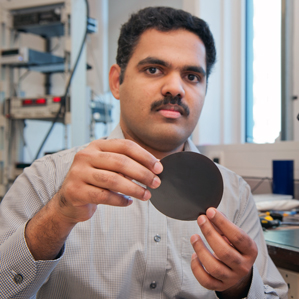How Can Desalination Become Cheaper?
Desalination, the process of removing salt from water, is expensive. Although large-scale desalination plants are running around the world—generally where it’s cheaper than pumping water from far away—there aren’t nearly enough to provide fresh water everywhere it’s needed.

One common desalination method, reverse osmosis, is expensive because it requires a great deal of electricity to push water through a filter. It’s also costly to treat the water to kill microbes and to replace the filters. Researchers are hoping that improved membrane materials could make this process cheaper.
Graphene Nanopores
Researchers hope that strong and lightweight graphene membranes can cost less and last much longer than today’s polymer membranes. Graphene generally repels water, but in the proper form it can separate salt from water quickly. Several different teams are researching ways to do that.
• Researchers at the University of Manchester have prepared graphene for use as a desalination membrane by introducing tiny capillaries into stacked layers of graphene oxide that allow water to pass through. These openings in the material are one atom wide. Very small salt molecules measuring less than a nanometer can pass through, but the team is working to improve the filter so that it weeds out even smaller particles. The research was outlined in Science in February.
• With a different method, researchers from MIT, the U.S. Department of Energy’s Oak Ridge National Laboratory, and Saudi Arabia’s King Fahd University of Petroleum and Minerals demonstrated graphene membranes with pores less than the size of a nanometer. Unlike the Manchester team, this group is introducing holes into a single-atom-thick layer of graphene, rather than through multiple sheets. This membrane design could be 50 times more water-permeable than today’s polymer filters, the researchers estimate, which means less energy would be required to push the liquid through. This membrane design is detailed in a Nano Letters paper published last February.
• MIT researchers David Cohen-Tanugi and Jeffrey Grossman showed that graphene with nanopores could withstand high pressure in this Nano Letters paper published on October 30.
• Last year, Lockheed Martin patented a membrane made from graphene that it says can desalinate water “at a fraction of the cost” of today’s systems.
Multitasking Membranes
While graphene has gained attention as a promising material for membranes, Singaporean researcher Darren Sun has spent years looking into another candidate: titanium dioxide. The Nanyang Technological University professor developed nanofibers made from titanium dioxide crystals. He then formed them into membranes to filter the water. The membranes could have multiple applications, including in a method of desalination known as forward osmosis. Sun believes they would outperform today’s polymer-based membranes because they can kill bacteria and reduce the clogging that prompts their replacement. He outlines the antibacterial property of his nanofibers in a December 2013 ChemPlusChem paper.
The Takeaway:
New membranes made from better materials could someday make desalination faster and cheaper. However, many of these technologies are only being done on a small scale and will require significant research and funding to be widely used.
Do you have a big question? Send suggestions to questionoftheweek@technologyreview.com.
Keep Reading
Most Popular
Large language models can do jaw-dropping things. But nobody knows exactly why.
And that's a problem. Figuring it out is one of the biggest scientific puzzles of our time and a crucial step towards controlling more powerful future models.
The problem with plug-in hybrids? Their drivers.
Plug-in hybrids are often sold as a transition to EVs, but new data from Europe shows we’re still underestimating the emissions they produce.
How scientists traced a mysterious covid case back to six toilets
When wastewater surveillance turns into a hunt for a single infected individual, the ethics get tricky.
Google DeepMind’s new generative model makes Super Mario–like games from scratch
Genie learns how to control games by watching hours and hours of video. It could help train next-gen robots too.
Stay connected
Get the latest updates from
MIT Technology Review
Discover special offers, top stories, upcoming events, and more.